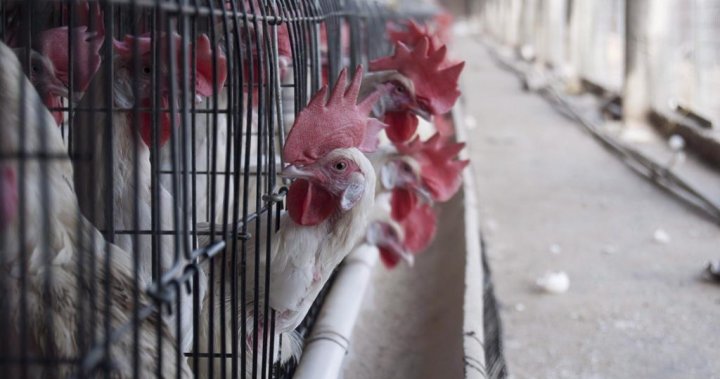Why bird flu is always a ‘red flag’: Canadian health care experts break it down – National | Globalnews.ca
While the risk from H5N1 influenza or bird flu virus remains low among humans, it’s always a “red flag” that requires monitoring, according to some Canadian experts.
“It’s a very nasty infection, so you never want to see bird flu spreading,” said Dr. Isaac Bogoch, an infectious diseases specialist at Toronto General Hospital.
“It’s always a red flag and it always requires surveillance and to be treated with the utmost concern,” Bogoch told Global News.
Read more:
Avian flu puts pressure on producers, consumers
Read next:
How rising food prices make eating healthy a big-time struggle for some Canadians
According to World Health Organization (WHO) Director-General Tedros Adhanom Ghebreyesu, H5N1 has been spreading among poultry and wild birds for 25 years. At a virtual briefing Wednesday, Tedros told reporters that recent incidents of infections in mink, otters and sea lions “need to be monitored closely” but maintained that the risk to human beings remains low for now.
“But we cannot assume that will remain the case and we must prepare for any change in the status quo,” Tedros said.
The WHO states on its website that “animal influenza viruses are distinct from human seasonal influenza viruses and do not easily transmit between humans.” However, an animal influenza virus like the bird flu “may occasionally infect humans through direct or indirect contact.”
How transmissible is bird flu?
The virus, according to Bogoch, is not easily transmitted from birds to humans and it’s not easily transmitted from humans to humans either. He noted that cases of bird flu in humans have been rare since the flu strain first emerged in 1996.
But, of all the reported cases of bird flu in history, just over half the people who get infected end up dying after experiencing symptoms like fever, chills, headache and shortness of breath, which implies how serious the virus is, said Bogoch.

The real issue, according to Bogoch, is whether a significant burden of these cases, added with non-human mammals living in close proximity to each other, would lead to a mutation in the virus and an eventual human outbreak.
While there’s no clear answer to that according to Bogoch, there certainly are ways to prepare for the possibility on an individual and government level.
Is Canada prepared for an outbreak?
For preventative measures on an individual level, Bogoch said people shouldn’t pick up or deal with dead or sick birds, whether they be wild or on a poultry farm.
The WHO advises that people not touch dead or sick wild animals and instead report them to local and national authorities who are monitoring the situation.
“At a government level, at a public health level, we should really be actively pursuing vaccination strategies for bird flu,” Bogoch said, noting that it’s already “being done.”
He also stressed the need for “good global surveillance, data collection and data sharing on what areas have bird flu and what type of bird flu it is.”

He said governments should also be looking into the genomic sequencing of the virus to see the manner in which it can mutate and result in more human-to-human transmission, especially since there are no vaccines or treatments available right now.
“It’s important to work on the therapeutics front as well, and designing therapeutics for influenza, which of course include human seasonal influenza, but also may include avian influenza as well. There’s a lot that needs to be done. A lot of this work is being undertaken now,” Bogoch added.
Read more:
Saskatchewan farm loses turkey stock following avian flu infestation
Read next:
Sleep-deprived Calgarian still waiting for CPAP machine following massive recall
Dr. Timothy Sly, epidemiologist and professor emeritus with Toronto Metropolitan University, said that the Public Health Agency of Canada (PHAC) and the Canadian Food Inspection Agency (CFIA) monitor and test samples of birds constantly across the country.
“Whenever there’s a dead bird, it’s not simply put into the compost, it’s rushed off to the lab and samples are taken because we want to be able to nail this the moment it appears,” said Sly.
In the event of an outbreak, the CFIA has a dedicated response team of experts to handle the situation, according to the agency’s website. The group includes veterinarians, executive management and field staff who are meant to oversee the CFIA’s response and “coordinate actions with federal, provincial and municipal partners.”
How does the virus spread?
The virus is not food-borne and none of the people who’ve become ill caught it through food, according to Sly. However, they may have come into contact with the raw meat of the infected dead bird during the cooking process, he said.
“Now, here’s the good thing … the bird flu virus does mutate constantly, just like the COVID virus. But for almost 30 years now we’ve not seen the virus mutate to the point of … making it a pandemic. It hasn’t happened,” said Sly.
This virus, according to the CFIA, has in the past been detected in “mammalian species including humans, rats and mice, weasels and ferrets, pigs, cats and dogs.”
But, there “have been no documented or reported cases” of the virus being transmitted to humans from mammalian pets, the agency says on its website.
However, the WHO is recommending the strengthening of surveillance in settings where humans and animals interact.
Read more:
B.C. bird flu outbreak ‘concerning,’ minister says, with 10 farms now infected
Read next:
Calgary becomes training hub for new miniaturized pacemaker: ‘Game changer’
“WHO is also continuing to engage with manufacturers to make sure that, if needed, supplies of vaccines and antivirals would be available for global use,” said Tedros.
According to Health Canada, hunters of traditional foods, like wild geese and duck, and the people who prepare these foods may be at a higher risk.
To help reduce any risk, the agency recommends Canadians cook game thoroughly to an internal temperature of approximately 71 C (160 F), and avoid direct contact with blood, feces and respiratory secretions of all wild birds.
It also recommends people to not eat, drink or smoke when cleaning wild game birds and to wear dish gloves or latex gloves when handling or cleaning game.
– with files from Reuters
For all the latest health News Click Here




